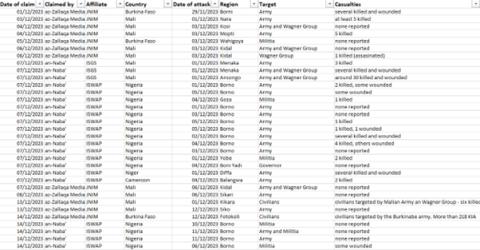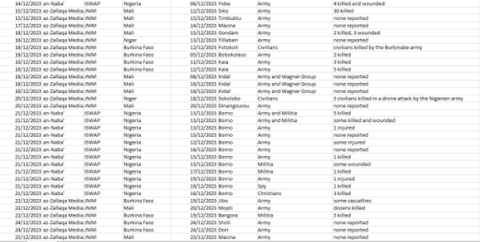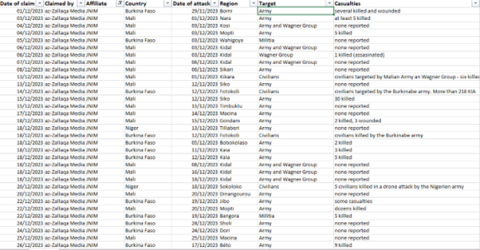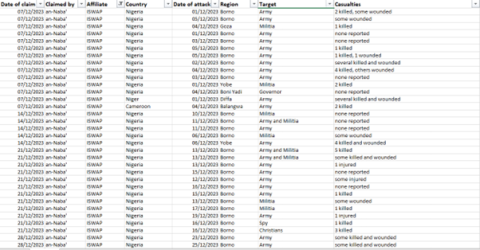Fact:
On April 3, 2017, the day Vladimir Putin was due to visit the city, a suicide bombing was carried out in the St. Petersburg metro, killing 15 people and injuring 64. An al-Qaeda affiliate, Imam Shamil Battalion, claimed responsibility.

For the first time since CEP reporting began in December 2022, the number of monthly attacks claimed by al-Qaida and ISIS affiliates in West Africa exceeded 90. In December 2023, the claimed number of attacks averaged three per day, just short of 100. This supports earlier CEP predictions that the number of claimed attacks would continue to increase in 2024. At the beginning of CEP’s reporting, regional terror groups claimed on average 38 attacks monthly. This increased steeply during 2023. A first peak was reached during the month of Ramadan 2023, which coincided with April 2023 with a total of 68 claimed attacks. After this peak the numbers somewhat stabilised again on a higher level. However, since October 2023, the monthly level of claimed terrorist violence by al-Qaida and ISIS affiliates in the region has continued to reach unprecedented levels. With 96 claimed attacks in December 2023, the year-by-year increase stands at 252.63 percent.

Graphic 1 : Claims by JNIM in the month Jumada al-Awwal 1445 AH (November 15 – December 13 2023)
The most affected countries remained the same throughout the entire reporting period. Nigeria is under constant attack by ISIS affiliate the Islamic State West Africa Province (ISWAP). The highest number of claims was reported in November with a total of 45 claimed attacks. Second on the list, plagued by both al-Qaeda’s affiliate JNIM as well as by the Islamic State in the Sahel (ISGS), is Mali with nearly 40 reported attacks in October. The two countries increasingly in the crosshairs are Burkina Faso and Niger.
As can clearly be seen in the infographic below, 2023 has witnessed a relatively steady increase of Jihadi terrorism related attacks in the region. However, the ferocity and deadliness of those related incidents has increased by almost a third in just one year.

Graphic 2: frequency and deadliness of Jihadi involved incidents
With the general trend of month-to-month increased attacks, more than ever before, the Sahel region has truly become the “epicentre of global Jihad,” as declared by al-Qaeda leader Abu Ubaydah Yusuf al-Anabi in a France 24 interview in March. Since al-Anabi uttered these words, it has become a reality: Not only al-Qaeda, but especially the two regional ISIS affiliates have been able to increase their operations in destabilising the region.
As shown in the infographic below, the overall problem is nothing particularly new to the area, yet the number of operations by Jihadi terrorist groups has been growing exponentially since the withdrawal of Western peace-keeping forces in the last few years. The overall destabilisation of the region throughout 2023 provided a fertile ground for terrorist groups to grow and expand their operational areas. The withdrawal of Western and UN forces from the region left a security vacuum, while the entry of Russian mercenary forces exacerbated radicalization in the region. Three states, Mali, Burkina Faso and Niger, experienced military coups and concomitant political instability. In all three countries, terrorist violence increased following these coups.

Graphic 3: Attacks in the Sahel Jan 1, 2012, to Jan 18, 2024
Source : https ://x.com/J_LuengoCabrera/status/1749451399065178207 ?s=20
As in previous months, the largest number of attacks during December 2023 were registered in Nigeria (37), closely followed by Mali (35), Burkina Faso (17), Niger (5) and Cameroon (2). In Mali, 15 attacks targeted the Malian army and the Wagner Group. Two of these clashes with the army and the Russian mercenaries were claimed by ISGS; one of these resulted in the killing and wounding of about 30 soldiers and mercenaries in Ansongo on December 1, when the local military base was overrun by the terrorists. The attacks in Mali are getting more intense over time. No fewer than 12 attacks were directly targeting military bases, resulting in a significant number of casualties.

Another trend that continues is the reporting by JNIM on massacres committed by the military in Mali and Burkina Faso. Despite its brutality, JNIM is skilfully using these incidents in its propaganda, portraying itself as the protector of the civilian population. Az-Zallaqa Media claimed that in one of the attacks, the Burkinabe army killed no fewer than 218 civilians in one day.

Insert 1: Example of a report on war crimes by the Malian army and the Wagner Group

Table 1: Claimed Attacks (December 2022 – December 2023)

Table 2: Claimed Attacks per Group (December 2022- December 2023)

Table 3: Claimed Attacks per Country (December 2022 – December 2023)

As previously noted, December 2023 broke all statistical records. No less than 96 incidents were claimed by the regional al-Qaeda and ISIS affiliates. For the first time since reporting started, the number of attacks claimed by az-Zallaqa Media surpassed 50. In addition, JNIM continued to grow and is on a trajectory to become the most significant terror group in the Sahel, and especially in Mali.
Nigeria experienced 37 attacks, all of which were of relatively low impact. The most remarkable was an attempt to attack the seat of the governor of Yoni Yade in Yobe. No casualties were reported, but ISWAP was aiming high in this attempt. Most of the attacks were aimed at the Nigerian armed forces, yet there were also claims of attacks on Christian villages, militias, alleged spies, and the Nigerian police.
Mali remains the most affected country by Jihadi terrorist attacks. As in previous months, JNIM remains the most impactful group with a total of 32 claimed attacks. However, there continues to be strong indications that ISIS is deliberately underreporting on its operations throughout the entire Sahel. In December, ISGS only claimed three attacks, all of them allegedly on December 1 in Menaka and Ansongo. Again, a suicide attack was reported by az-Zallaqa Media, resulting in the take-over of an army base and the looting of an enormous amount of military equipment.

In Burkina Faso, JNIM reported 17 incidents. Two JNIM propaganda posts alleged that the Burkinabe army was responsible for massacres in the area of Fotokoli, killing more than 218 civilians. In revenge JNIM claimed to have attacked several military bases, resulting in more than 110 Burkinabe soldiers killed and dozens wounded.
Only two low-level attacks were claimed in Cameroon by ISWAP.
Five incidents were claimed in Niger, three by ISWAP and two by JNIM. It is remarkable that JNIM, again, promotes itself as the protector of the local population, openly condemning the death of five Nigerien citizens in a drone attack by the Nigerien army.
Table 4: Total number of attacks



In total 51 incidents were claimed by JNIM, 32 in Mali, 17 in Burkina Faso, and two in Niger. On several occasions JNIM propaganda did not report on its own operations, but rather reported on attacks allegedly carried out by the military and their auxiliaries targeting the civilian population JNIM claims to protect.
Table 5: Attacks by JNIM


As usual, the operational focus of ISWAP was Nigeria. Although the number of attacks has doubled since reporting began, most of them remain low level. It seems that ISWAP organises a significant number of attacks but does not always conduct them effectively.
Table 6: Attacks by ISWAP


ISGS claimed just three attacks in Mali. However, as in the past, there are strong indications that the group conducted a significantly higher number of terrorist operations, and that its propaganda wing deliberately chooses to underreport.
Table 7: Attacks by ISGS

The continuing increase in terrorist violence made 2023 a challenging year for the region, and every indication points to significantly worse violence in 2024. Last month CEP predicted that in 2024, “the average number of monthly attacks will increase to over one hundred claims, even if the systematic underreporting of attacks by ISGS continues.” In December 2023, the overall level of violence in the region has nearly reached this level. Given the growing level of terrorist violence, the increasing territorial expansion of terrorist operations, and continuing regional political instability, it is a virtual certainty that countries currently unaffected by violent extremists will be threatened soon. And given this situation, it is increasingly likely that it is no longer a question of “if” but only of “how” and “when” this increasing Jihadi terrorist violence will reach Europe.
Extremists: Their Words. Their Actions.
Fact:
On April 3, 2017, the day Vladimir Putin was due to visit the city, a suicide bombing was carried out in the St. Petersburg metro, killing 15 people and injuring 64. An al-Qaeda affiliate, Imam Shamil Battalion, claimed responsibility.
Get the latest news on extremism and counter-extremism delivered to your inbox.